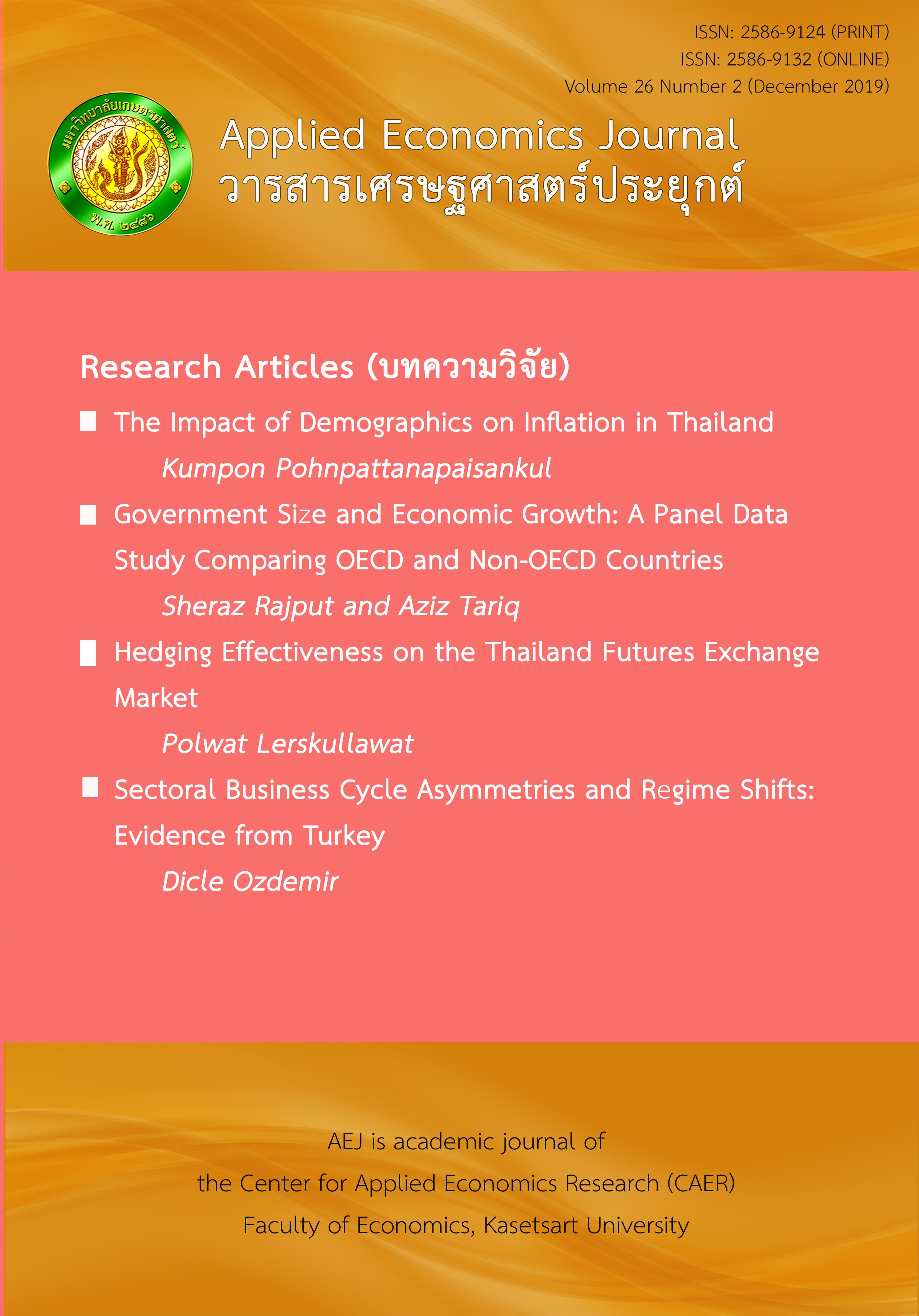Government Size and Economic Growth: A Panel Data Study Comparing OECD and Non-OECD Countries
Main Article Content
Abstract
This study examines the non-linear relationship between government size and economic growth following Armey (1995). Generalized Method of Moments (GMM) estimation technique is applied to panel data consisting of 89 countries from 1990 to 2018. The results show substantial evidence for Armey curve across non-OECD countries. The findings suggest that a rise in government size initially enhances economic growth but later government size reduces economic growth once the government size crosses a certain threshold. However, the findings relating to the OECD countries do not support the presence of Armey curve.
Article Details
The paper is published under CC BY-NC-ND, in which the article is freely downloaded and shared in its original form non-commercially and its citation details are identified.
References
Acemoglu, D., Johnson, S., & Robinson, J. A. (2005). Institutions as a fundamental cause of long-run growth. In P. Aghion & S.N. Durlauf (Eds.), Handbook of Economic Growth, Volume 1A (pp.385-472). Amsterdam: North Holland.
Alderman, H., Behrman, J. R., Ross, D. R., & Sabot, R. (1996). The returns to endogenous human capital in Pakistan's rural wage labour market. Oxford Bulletin of Economics and Statistics, 58(1), 29-55.
Arellano, M., & Bond, S. (1991). Some tests of specification for panel data: Monte Carlo evidence and an application to employment equations. The Review of Economic Studies, 58(2), 277-297.
Armey, R. (1995). The freedom revolution. Washington, DC: Rogney Publishing Co.
Bjørnskov, C. (2005). Does political ideology affect economic growth? Public Choice, 123(1-2), 133-146.
Borensztein, E., De Gregorio, J., & Lee, J. W. (1998). How does foreign direct investment affect economic growth? Journal of international Economics, 45(1), 115-135.
Cashin, P. (1995). Government spending, taxes, and economic growth. Staff Papers, 42(2), 237-269.
Chen, S. T., & Lee, C. C. (2005). Government size and economic growth in Taiwan: A threshold regression approach. Journal of Policy Modeling, 27(9), 1051-1066.
Coale, A. J., & Hoover, E. M. (1958). Population growth and economic development in
low-income countries: A case study of Indias prospects. New Jersey: Princeton University Press.
Connolly, M., & Li, C. (2016). Government spending and economic growth in the OECD countries. Journal of Economic Policy Reform, 19(4), 386-395.
Dar, A. A., & AmirKhalkhali, S. (2002). Government size, factor accumulation, and economic growth: evidence from OECD countries. Journal of Policy Modeling, 24(7), 679-692.
De Long, J. B., & Summers, L. H. (1990). Equipment investment and economic growth. Quarterly Journal of Economics, 106(2), 445-502.
Deger, S., & Smith, R. (1983). Military expenditure and growth in less developed countries. Journal of Conflict Resolution, 27(2), 335-353.
Engen, E. M., & Skinner, J. (1992). Fiscal policy and economic growth (NBER Working Paper No. 4223). Cambridge, MA: National Bureau of Economic Research.
Folster, S., & Henrekson, M. (2001). Growth effects of government expenditure and taxation in rich countries. European Economic Review, 45(8), 1501-1520.
Frankel, J.A., & Romer, D.H. (1999). Does trade cause growth? American Economic Review, 89(3), 379-399.
Grossman, P. J. (1987). The optimal size of government. Public Choice, 53(2), 131-147.
Haan, J., & Sturm, J.-E. (2000). On the relationship between economic freedom and economic growth. European Journal of Political Economy, 16(2), 215-241.
Islam, N. (1995). Growth empirics: a panel data approach. The Quarterly Journal of Economics, 110(4), 1127-1170.
Jin, J., & Zou, H. F. (2002). How does fiscal decentralization affect aggregate, national, and subnational government size? Journal of Urban Economics, 52(2), 270-293.
Jones, E. (1981). The European miracle: environments, economies and geopolitics in the history of Europe and Asia. New York: Cambridge University Press.
Kelley, A. C., & Schmidt, R. M. (1996). Saving, dependency and development. Journal of Population Economics, 9(4), 365-386.
Kormendi, R. C., & Meguire, P. (1986). Government debt, government spending, and private sector behavior: reply. The American Economic Review, 76(5), 1180- 1187.
Landau, D. (1983). Government expenditure and economic growth: a cross-country study. Southern Economic Journal, 49(3), 783-792.
Lee, Y., & Gordon, R. H. (2005). Tax structure and economic growth. Journal of Public Economics, 89(5), 1027-1043.
Lin, S. A. (1994). Government spending and economic growth. Applied Economics, 26(1), 83-94.
Mankiw, N. G., Romer, D., & Weil, D. N. (1992). A contribution to the empirics of economic growth. Quarterly Journal of Economics, 107(2), 407-437.
Persson, T., & Tabellini, G. (1994). Is inequality harmful for growth? The American Economic Review, 84(1), 600-621.
Ram, R. (1986). Government size and economic growth: A new framework and some evidence from cross-section and time-series data. The American Economic Review, 76(1), 191-203.
Rostow, W. W. (1959). The stages of economic growth. The Economic History Review, 12(1), 1-16.
Sheehey, E. J. (1993). The effect of government size on economic growth. Eastern Economic Journal, 19(3), 321-328.
Tanzi, V., & Zee, H. H. (1997). Fiscal policy and long-run growth. Staff Papers, 44(2), 179-209.
Temple, J. (1999). The new growth evidence. Journal of Economic Literature, 37(1), 112-156.
Vedder, R. (2001). Taxes and Economic Growth. Wiscousin: Taxpayers Network, Inc.
Vedder, R. K., & Gallaway, L. E. (1998). Government size and economic growth. Washington, DC: Joint Economic Committee.


